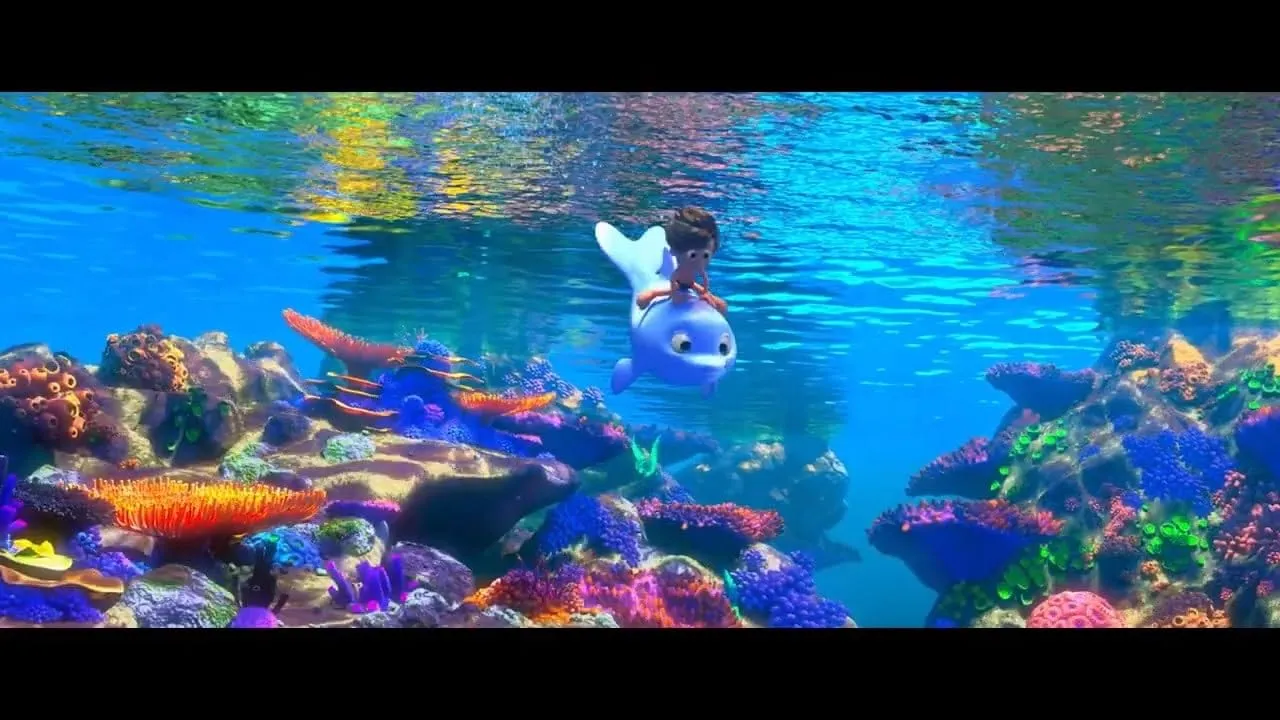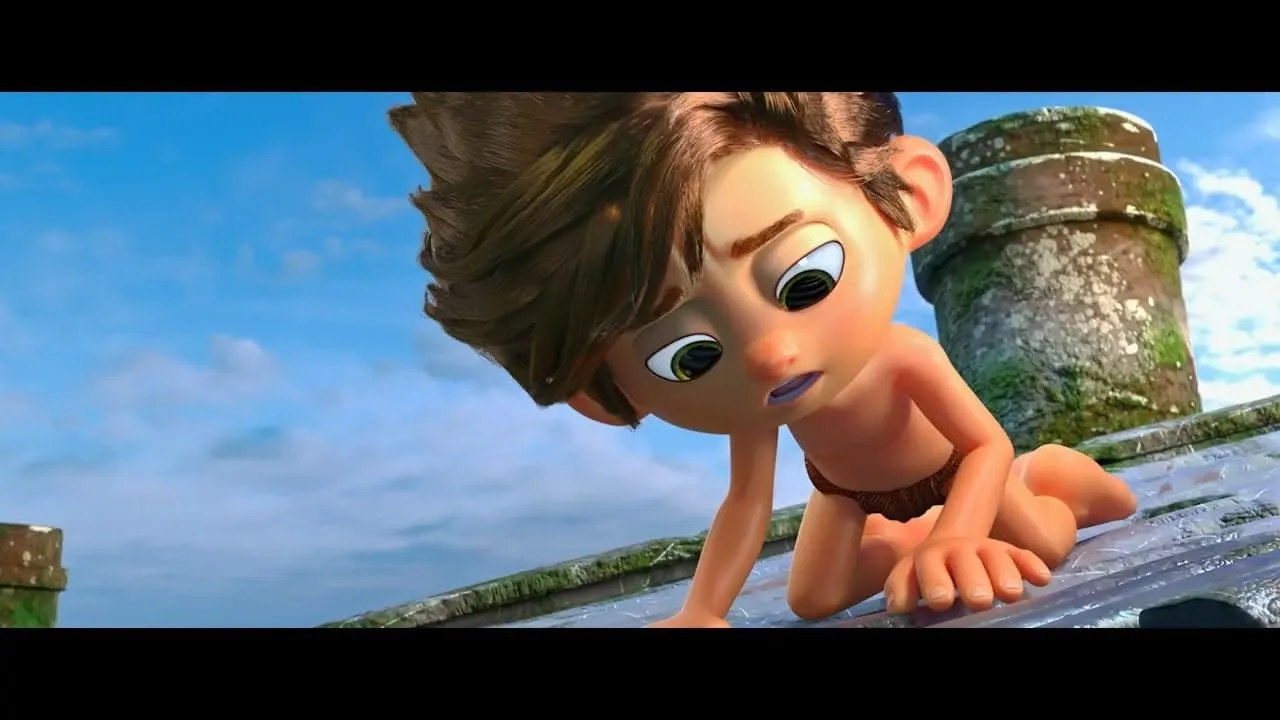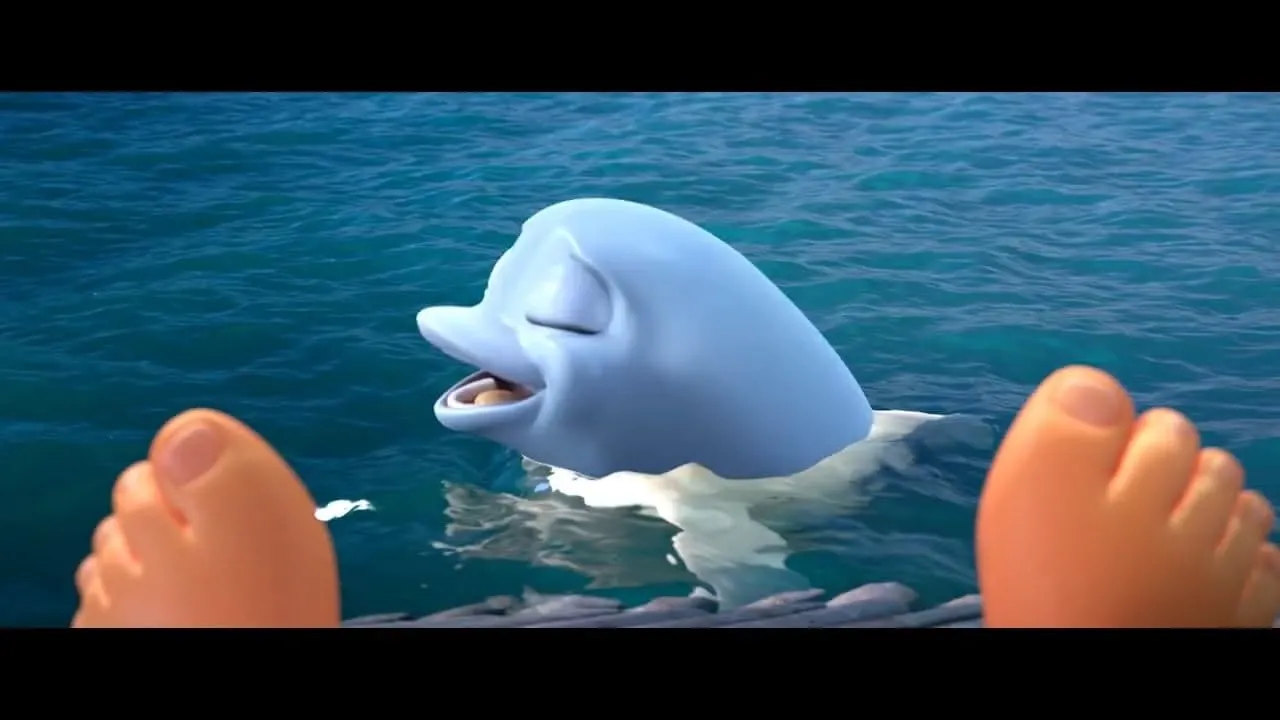Blu and Flippy – Friends for the Fins introduces us to Blu, a boy who is rescued from a plane crash and raised by a family of dolphins. His life in the sea is carefree, alongside his dolphin friend Flippy. But when a menacing octopus threatens their world, Blu’s peaceful existence is disrupted. This forces him to leave his home and venture onto land in search of answers.
The film touches on familiar themes: a child raised outside of human society, echoing stories like Tarzan and The Jungle Book. But it also offers a unique twist, as Blu not only seeks to understand his origins but also grapples with environmental threats.
As Blu moves toward the human world, the story shifts, mixing his personal journey with an urgent environmental conflict. While the emotional heart of the film centers on Blu’s quest for identity, it’s also about navigating the complications of being part of two worlds—one underwater, the other on land.
The unfolding plot, though familiar, presents opportunities for reflection. Blu’s story is more than just about a lost child finding his way; it also mirrors the larger question of how individuals—and nature itself—are affected by forces beyond their control.
But with its shift between the water and land, the film risks losing some of its clarity in execution. This transition is jarring for both Blu and the audience, making it a tricky balance to maintain as the film moves forward.
Blu, Flippy, and the Depths of Connection
Blu’s transformation is central to Blu and Flippy – Friends for the Fins. Starting as an innocent child, unaware of his true origins, he grows into a character grappling with identity and belonging.
Raised by dolphins after a plane crash, Blu initially thrives in the ocean, but as his world is disrupted, he is forced to confront a larger reality: he is different. This shift from carefree to self-consciousness provides an emotional arc that resonates deeply, especially as Blu begins to question where he truly fits in the world.
His search for his mother becomes more than just a quest for family—it’s a reflection on isolation and the personal struggle to understand one’s place in the vastness of the world.
Flippy, the dolphin who becomes Blu’s closest friend, plays an essential role in Blu’s journey. Their bond is built on trust and affection, with Flippy providing a sense of stability and adventure in a world that is growing more uncertain for Blu.
Unlike the chaotic shifts Blu faces in his environment, Flippy offers him companionship that doesn’t waver, allowing their relationship to grow into something truly special. Their teamwork and support for one another become key elements in navigating the challenges they face, especially as they confront the dangers of the octopus.
The secondary characters also leave their mark. The octopus, acting as the environmental antagonist, adds urgency to the story, representing the larger threat to the ocean and its creatures. Meanwhile, the captain who helps Blu on land offers a different perspective, symbolizing the human world Blu is trying to understand.
Yet, it is the dynamic between Blu and Flippy that anchors the film, their connection providing the emotional strength needed to navigate both their personal struggles and the threats to their world.
Thematic Depths: Environmentalism, Family, and Identity
Blu and Flippy – Friends for the Fins touches on deep, resonant themes, particularly environmentalism and the fragility of the ocean. The film’s exploration of ocean pollution serves as both a narrative conflict and a subtle reminder of humanity’s impact on the natural world.
As Blu and his dolphin family face the destructive force of an oil-spilling octopus, the film paints a picture of an ecosystem under siege. This theme runs parallel to Blu’s personal journey, reinforcing that the fight for survival isn’t only a matter of species but of the balance of nature itself. The conflict emphasizes not just the perilous beauty of the underwater world, but the importance of protecting it.
Family and belonging also play a central role. Blu’s connection to his dolphin family, especially to Flippy, underscores the idea that family is not defined by biology, but by care, trust, and emotional support. This dynamic adds warmth and depth to the narrative, contrasting with Blu’s search for his biological mother.
His quest symbolizes a deeper exploration of self, moving beyond the physical to consider identity itself. Blu’s journey toward understanding his origins highlights the universal desire for acceptance, a theme that resonates with anyone who has ever searched for a sense of belonging.
Through his evolving relationships and internal conflict, the film places a strong focus on identity, as Blu navigates the complexities of being both a creature of the sea and a human. His struggle to understand his place in the world shapes the emotional fabric of the story.
A Splash of Color: Animation and Visual Style
Blu and Flippy – Friends for the Fins offers an animation style that is both simple and engaging. The character designs are clean and expressive, using large, emotive eyes and soft features to bring the characters to life without overwhelming the viewer.
This simplicity is ideal for a younger audience, ensuring the characters remain relatable and easy to connect with. The bright color scheme enhances this, creating an inviting atmosphere for the underwater world, where Blu and Flippy’s adventures unfold. The cheerful tones work well to convey a sense of lightheartedness, matching the playful nature of the characters.
The depiction of the ocean as a dynamic and thriving ecosystem is one of the film’s strengths. The underwater world feels full of life, with various creatures adding richness to the environment.
While the setting itself is vibrant and full of potential, the film’s animation quality sometimes falters, especially in the more action-heavy moments.
The CGI lacks a smoothness that could have added more fluidity to the sequences, occasionally pulling the viewer out of the otherwise immersive world. Despite this, the overall visual style is charming and does an effective job of drawing viewers into its colorful, aquatic setting.
Shifting Tides: Tone, Genre, and Emotional Flow
Blu and Flippy – Friends for the Fins presents an interesting blend of light-hearted adventure and darker undertones. The film begins with an easygoing, joyful underwater life, filled with playful moments between Blu and Flippy.
These sequences invite the audience into a world of innocence, where the stakes seem low, and the mood is carefree. However, as the film progresses, the tone shifts dramatically.
The introduction of the villainous octopus introduces a real threat to their peaceful world. The transition from fun to danger catches both Blu and the viewer off guard, forcing them to reckon with the higher stakes of the narrative.
This contrast between playful adventure and intense peril can be jarring. The sudden increase in tension, particularly during the suspenseful and action-heavy scenes involving the octopus, may feel abrupt to younger audiences, who are used to the lightheartedness of earlier scenes.
The film attempts to juggle multiple genres—from family fun to moments of suspense and horror—but in doing so, it risks alienating some viewers, especially when these shifts in tone happen without much warning.
The emotional journey of Blu lies at the heart of the story. As the young boy moves from innocence to awareness, the emotional weight of his bond with Flippy and his adopted dolphin family adds significant depth to the narrative.
His internal struggle, torn between his two worlds, amplifies the emotional stakes as he begins to understand not only who he is but where he truly belongs. The dynamic between Blu and his dolphin family offers a strong emotional anchor, elevating the film’s exploration of identity and connection.
The Pace of Discovery: Pacing and Narrative Flow
Blu and Flippy – Friends for the Fins struggles with pacing, particularly as the plot moves quickly through key events. The story often advances with little time to let its emotional moments breathe, making it difficult to fully absorb the narrative’s weight.
For younger viewers, this fast pace may make it challenging to follow the shifting plotlines. As Blu navigates multiple quests—seeking his mother, facing the villain, and transitioning to the human world—the film packs in a lot, but at times, it doesn’t allow enough time for any one arc to truly develop.
The transition from underwater to land-based scenes adds to the pacing issues, as the film shifts from the serene, colorful ocean to a more hectic human environment. This change in setting, while necessary for Blu’s journey, disrupts the story’s rhythm, creating a disjointed flow.
The mix of action, suspense, and mystery in these later scenes can overshadow the emotional depth of the characters, especially Blu. The film often prioritizes plot development over deeper character exploration, which, while keeping things moving, detracts from the richness of Blu’s emotional journey.
Emotional Undercurrents: Themes and Impact
Blu and Flippy – Friends for the Fins navigates complex themes such as family, identity, and environmentalism. Blu’s bond with Flippy offers an emotional anchor, underscoring the strength of relationships that transcend biological ties.
However, the film’s pace can sometimes rush through these moments, not allowing the emotional stakes to land as deeply as they could. Blu’s quest for self-discovery is an emotional thread that ties the narrative together, but the story’s quick shifts between key plot points may detract from the deeper exploration of this theme.
The environmental message about ocean pollution stands out, with the underwater world’s vulnerability reflecting Blu’s personal struggle.
The narrative does a solid job of tying the two together, though the pace can obscure the weight of this conflict. As the action intensifies, there’s a tendency to lean more into spectacle than introspection, leaving some emotional arcs underdeveloped, especially in the quieter moments.
The Review
Dolphin Boy
Blu and Flippy – Friends for the Fins offers a heartwarming exploration of family and self-discovery but is often hindered by pacing issues and tonal inconsistencies. While the emotional core between Blu and his dolphin family is touching, the film's rapid progression and abrupt genre shifts may alienate younger audiences. Its environmental message is a strong point, but the storytelling struggles to fully balance its adventure and deeper themes.
PROS
- Heartfelt emotional connection between Blu and Flippy.
- Strong environmental message about ocean pollution.
CONS
- Pacing issues make the story feel rushed.
- Tonal shifts may confuse younger viewers.
- Lack of emotional depth in some character moments.





















































